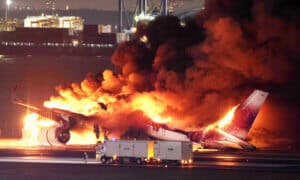JAPANESE AIRBUS A-350 CRASH REVEALS DANGERS OF COMPOSITE AIRPLANES
JAPANESE AIRBUS A-350 CRASH REVEALS DANGERS OF COMPOSITE AIRPLANES
 The Japan Airlines Airbus A-350, the latest of the Airbus family and made primarily of composites burned like a tinder box after colliding with another aircraft on landing. It should have just smoldered.
The Japan Airlines Airbus A-350, the latest of the Airbus family and made primarily of composites burned like a tinder box after colliding with another aircraft on landing. It should have just smoldered.
The conflagration was stunning in its intensity and appeared to be fueled by the widespread use of composite materials in that aircraft. One would have thought that regulators would have required some measure of fire retarding materials be utilized but whatever was required clearly wasn’t enough.
Other composite aircraft are in service like the Boeing 787 and more are on the way.
Another shocking observation was the lack of effective fire fighting and fire suppression from the fire fighting vehicles at the airport. It was only by pure luck and no doubt a skillful cabin crew that all passengers and crew made it out of the aircraft safely.
This accident without loss of life aboard the Airbus is an early warning that something has to be done to protect passengers from fire in composite aircraft in otherwise survivable accidents.
Doubtless nothing will be done until a planeload of passengers and crew die a fiery death because that’s the way the system works. Government officials responsible to protect the flying public will offer their thoughts and prayers and ten years or so later they will change the rules but not for aircraft in service.
Composite aircraft are a welcome advancement in aircraft construction because they are so light and are very strong allowing for large increases in economies of operation. The unknowns are fire resistance, the effects of free radicals changing the properties of the composites over time and damage tolerance.
The industry got a free pass on this accident.
Arthur Alan Wolk
January 2, 2024


